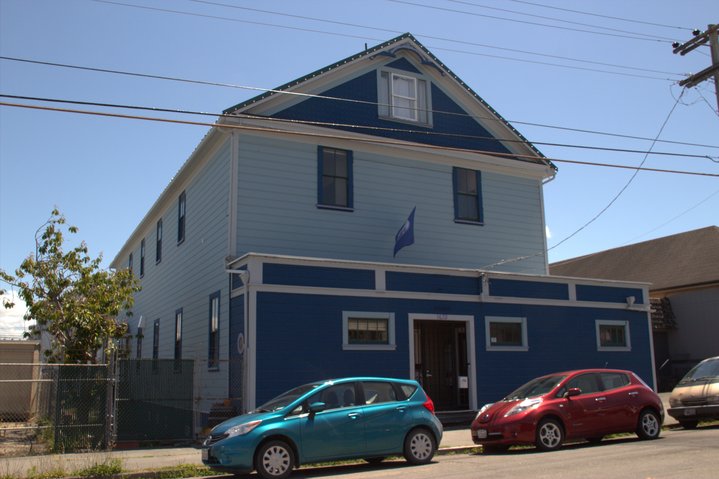
The former union hall at 1675 Union Street has been remade as the new home of Synapsis. | Photos by Jacquelyn Opalach.
###
After 17 years dazzling Humboldt at its small birthplace in Old Town Eureka, Synapsis — an artist collective founded and directed by Eureka City Councilmember Leslie Castellano — is gearing up for a grand opening at its new location in south residential Eureka.
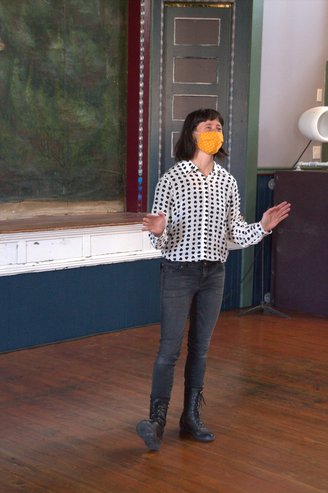
Synapsis Director Leslie Castellano.
Crammed with relics of former occupants, the large taupe building at 1675 Union Street was a time-capsuled wasteland by the time Castellano and her crew first viewed the property a couple of years ago. Beneath the leaks and the mold was a historic community hall, and Castellano bought it with plans to revive the building to its original glory with a circus-y twist.
“The building was close to being a teardown when we got it,” Derek Shaw, a Synapsis collective member, said, standing in the building’s welcoming and surely unrecognizable performance hall. “Which is also why we could afford it; no one else wanted it,” he added. “But for us, we could see the value.”
Founded in 2004, Synapsis — which is a DreamMaker project of the Ink People — is an artist collective with emphasis on aerial silks and dance. The original Old Town location became a dependable Arts Alive! staple over the years and hosted many performances, but it was rented, small and stageless. “I’m thankful to the people I’ve rented from, but, you know, there’s only so much you can do within a space that isn’t yours,” Castellano said.
“We wanted a hall,” Shaw specified. “Who else wants that?”
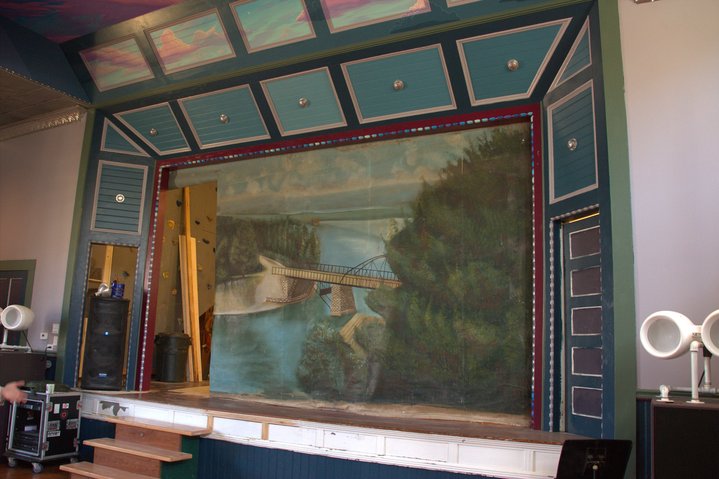
A canvas painting discovered in the basement now hangs in the main hall of the new Synapsis building.
From gym owners to growers, several businesses have cycled through the building over the last couple of decades. There are neat hints of former occupants scattered throughout the building, like a climbing wall from its gym days (stage right) or a massive canvas painting Synapsis members discovered in the basement, which they think was created by some very early occupants, if not the original builders. When Synapsis arrived with hopes to restore the building’s community-oriented features, it had been vacant for two and a half years and had seen only irregular use for about five years before that.
The historical significance of this hall, located across the street from the CalTrans building, is important to its new occupants. Built in 1904, the building served as a gathering site for a string of immigrant communities in early 20th century California, originally operating as a Finnish community hall. Synapsis doesn’t know much about the builders. “No one really is alive from then, ‘cause it was so long ago that it was actually active as a hall,” said Shaw, adding that if anyone has information about the building’s history, Synapsis would love to learn more.
Castellano suspects that a 1935 union strike, which resulted in several deaths and happened at a saw mill where the Bayshore mall now stands, was planned in the building.
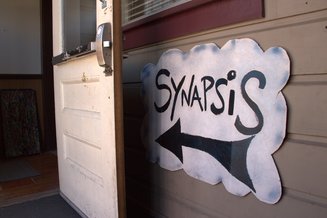
“I have hopes of putting some sort of historical marker up,” Castellano said. “Some part of that story of the past is tied into how we perceive ourselves today, [and is] present in the building and in the neighborhood as well, because, you know, the neighborhood has changed over the years. And in some ways, it’s currently in the process of a lot of change.”
The move to Union Street — where there is less foot traffic, more car traffic, and virtually no public art — is a significant shift in atmosphere that Castellano is excited about.
“This is a change of location that will allow us to engage with people who live in the area in a different way,” Castellano said. “I think Eureka has such a strong arts community that there’s kind of space to expand.”
Arts in Eureka are largely concentrated in Old Town, especially because of Arts Alive!, Castellano said. She appreciates and loves that scene and noted she’ll miss being a piece of the Arts Alive! “But there’s a lot of people who don’t go to [Arts Alive!], you know, because they don’t feel like it’s their scene, and I think in a neighborhood you get to kind of mix it up a little bit more. This is your scene because you live next door,” she said.
“I would maybe generalize to say that there may be a real need and desire for art spaces within more residential areas because it allows people to access the arts in a way that is more immediate, and is more about how we live our lives.”
Castellano isn’t worried about losing Synapsis collaborators, participants or audience members now that they’ve moved. “I think, because we’ve been around for so long, that we’re relatively known at this point,” she said. “I think it would have been harder to start a performance space here, having no history.”
After arriving in the neighborhood in February 2020, Synapsis was prevented by the pandemic from initiating relationships with their new neighbors until very recently. So far, the space has only been used for classes and as a private gym for existing Synapsis members.
“We haven’t been able to really engage with the community in a way that we think is of our nature,” Castellano said. But now, with decreased COVID danger and increasingly reliable weather, Synapsis is cautiously reentering the scene. A few weeks ago the collective hosted Outer Roominations, a site-specific event which featured a collection of outdoor trails that wove through temporary art installments. (The Outpost’s Andrew Goff was also an organizer and host of that event.)
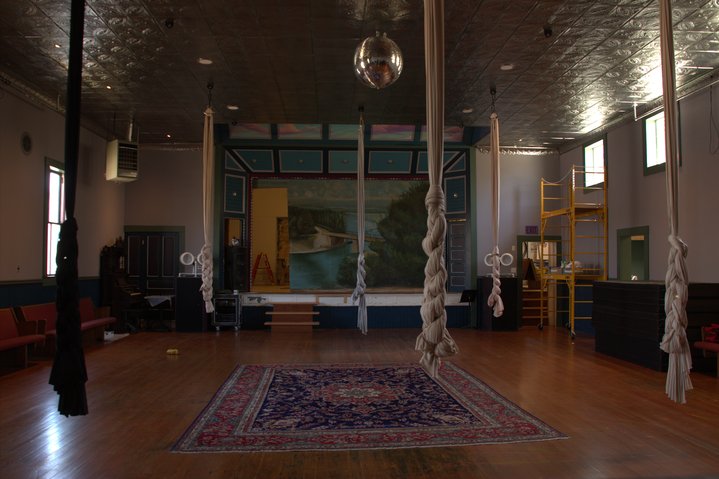
Aerial silks hang from the ceiling in the former union hall.
###
Synapsis is now in the midst of its first onsite public event. With specific hopes to attract members of their new neighborhood, they’ve been closing off Union street every Saturday to host a series of free outdoor dance and drum lessons, which are open to all and will continue until July 10.
“We went around and fliered the neighborhood for the classes,” Castellano said. People are attending them “because they live here, and because they can walk here.” She hopes to pick the lessons back up in the fall, and maybe create a “fun and funky” drum and dance ensemble to bring to events.
“This is, I think, the step towards a relationship that we hope to be ongoing and to build over many years,” Castellano said. “Hopefully people in Eureka will really see Synapsis as a resource for their own imaginations, you know, as well as a resource for coming and seeing amazing performances.”
With potential lingering COVID restrictions in mind, Castellano is thinking a two-week series of separate small events — like dance parties, aerial shows and music performances — might be wiser than one big event for their grand opening, which is tentatively scheduled for October.
And although Synapsis has been itching to finally connect with their new community, the timing of their move lined up conveniently with COVID closures given all the renovations the building needed. “Every square inch of the building gets touched at least 10 times, you know, through some sort of process,” Castellano said.
Though their restorations aren’t complete, Synapsis has made remarkable progress from the shambles they started with. So far every surface in the main hall has been revitalized. They outfitted the formerly leaky ceiling with patterned tin panels, a mural by Blake Reagan, disco ball and, of course, several aerial silk suspensions. They ripped out thousands of staples fastening moldy fiberboard to the ground and restored the building’s original hardwood floor. They coated the interior and exterior with fresh paint, subbing out the previous underwhelming brown for a bright blue outside. Next they’ll tackle the stage, lobby and smaller rooms around the building.
“I remember, when I was a kid, the first time I went to a big concert hall — and, you know, I wasn’t from a family that went to those things, really — it just seemed like everything was so special. And I really want kids in this neighborhood to walk in and be like, ‘Oh, this place is special, and it’s our place,’” Castellano said. “Giving that kind of level of quality and care to the space feels really important, for us as an artist collective, but also for, you know, the community around us.”
CLICK TO MANAGE